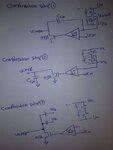Junus2012
Advanced Member level 5
Exactly FvM that was the thing I mean, from the oscillation at the output in closed loop system after applying the step input signal indicate the stability. Thank you for your confirmation.
Could you please FvM suggest me a method of stabilizing my CMFB loop rather than reducing the CM gain,
Do you think if I move the VCMFB (or the Vcms) control voltage to the upper mirror of the cascode amplifier (vbias7 in my circuit image) will have better stability than my current one (now I am controlling the down mirror of the cascod stage).
I am again posting my circuit to easy referring to it

Thank you once again
Could you please FvM suggest me a method of stabilizing my CMFB loop rather than reducing the CM gain,
Do you think if I move the VCMFB (or the Vcms) control voltage to the upper mirror of the cascode amplifier (vbias7 in my circuit image) will have better stability than my current one (now I am controlling the down mirror of the cascod stage).
I am again posting my circuit to easy referring to it

Thank you once again
